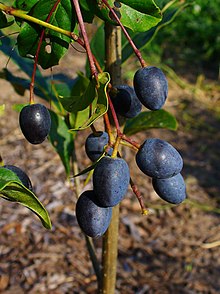Chionanthus virginicus
| Chionanthus virginicus | ||||||||||||
|---|---|---|---|---|---|---|---|---|---|---|---|---|

Chionanthus virginicus , blooming |
||||||||||||
| Systematics | ||||||||||||
|
||||||||||||
| Scientific name | ||||||||||||
| Chionanthus virginicus | ||||||||||||
| L. |
Chionanthus virginicus , also known as Virginian snowflake bush , Virginian snow tree or poison ash , is a deciduous tree species from the genus of snow trees ( Chionanthus ) in the olive family (Oleaceae). The species isnative toeastern North America . The first description by Carl von Linné was published in "Species Plantarum" in 1753, at that time still with the specific epithet virginica .
description
Chionanthus virginicus usually grows as a multi-stemmed shrub or smaller tree , forms a relatively slender, rounded crown and reaches heights of up to 10 meters and trunk diameters of up to about 30 cm. The bark is brown-gray and cracked to scaly or knotty.
In contrast to most of the members of the genus, Chionanthus virginicus is not evergreen but deciduous. The opposite, mostly pointed, simple and short-stalked leaves are ovate, lanceolate to elliptical, lanceolate, 10 to 20 cm long and 2 to 12 cm wide. The short petiole is up to 2 cm long and the leaf margin is whole; the leaf veins on the underside are hairy. The autumn color is yellow in northern latitudes, and inconspicuously brown in southern regions.
Axillary and hanging, stalked and mostly bald panicles are formed. There are leaf-like bracts and prophylls on the partly hairy inflorescence stalks , and leaf-like bracts again on the side axes. The fragrant, mostly functionally unisexual or, more rarely, hermaphrodite, four-fold flowers have four to six white, 2 to 3 cm long, linear petals . The flowers are stalked and the small, four-lobed calyx is bare. The two-chamber ovary is upper constant, with short stylus , the scar is in two parts, -lappig.
The egg-shaped, olive-shaped stone fruits are dark purple and sometimes "frosted" with a white powdery wax layer. They are up to about 1.1–1.9 cm long, with thin pulp and usually contain one to three woody and light brown stone pits, 8–10 mm in size.
distribution
Chionanthus virginicus is native to southeast to eastern North America . The distribution area extends over the US states of New Jersey , Pennsylvania , West Virginia , Missouri , Oklahoma and Texas , Alabama , Florida , Georgia , Maryland , North Carolina and South Carolina .
use
Because of its striking white flowers, Chionanthus virginicus is a very popular ornamental tree, especially in North America.
The fruits are edible. They are also pickled and serve as an olive substitute.
Individual evidence
- ↑ Chionanthus virginicus in the Germplasm Resources Information Network (GRIN), USDA , ARS , National Genetic Resources Program. National Germplasm Resources Laboratory, Beltsville, Maryland.
literature
- Robert K. Godfrey, M. Darst: Trees, Shrubs, and Woody Vines of Northern Florida… Univ. of Georgia Press, 1988, ISBN 0-8203-1035-2 , p. 498.
- C. Frank Brockman: Trees of North America. St. Martin's Press, New York 2001, ISBN 1-58238-092-9
- Edward F. Gilman, Dennis G. Watson: Chionanthus virginicus (PDF) (English)
- Marilena Idžojtić: Dendrology. Academic Press, 2019, ISBN 978-0-12-819644-1 , p. 160.
Web links
- Chionanthus virginicus on baumkunde.de.
- The Virginian Schneflockenstrauch: Chionanthus virginicus on flora-obscura.de, accessed on September 17, 2019.
- Chionanthus virginicus on missouriplants.com (English)
- Chionanthus virginicus at USDA (English)
- Chionanthus virginicus on Useful Temperate Plants (English)


